The way I see it, there are six potential outcomes of the Ervin Santana saga.
- Ervin Santana is traded prior during the 2013 season.
- Ervin Santana is held on to and following the season, he declines a qualifying offer, resulting in a draft pick netted by Kansas City. (Last season these picks fell in the 28-33 range.)
- Ervin Santana is held on to following the season, declines the qualifying offer, but fails to sign with a Major League team prior to the draft. (I find this extremely unlikely, barring a wretched second half.)
- Ervin Santana is held on to and following the season, he accepts a qualifying offer.
- Ervin Santana's contract is extended.
- Ervin Santana is traded, but then resigns with Kansas City.
As difficult as it is to put a valuation on these different outcomes, I wanted to attempt to quantify the value of option number 2.
First, what is the value of having Santana between now and the end of the season. Without getting too technical let's put this number at 1.5 bWAR. Santana has made 19 starts and is worth 2.1 bWAR thus far. If he makes 14 more starts and maintains his current value, he'll finish the year worth 3.6 bWAR.
On a side note, Fangraphs values 1 fWAR at $5.05 mil. Santana is currently on track to finish with 3.6 fWAR (oddly the same number as bWAR), which would mean he will be worth $18.18 million to Kansas City this season. At the time of his trade to Kansas City, the primary criticism is that his performance couldn't justify the $12 million that the Royals would owe him. The Royals still owe Santana roughly $4 million and if he keeps pace, he'll provide his team roughly $7.6 million in value according to Fangraphs.
In addition to the value that Santana would provide the Royals over the remainder of the season, there is also the value of the draft pick that needs to be discussed. In the 2013 draft, the compensation picks fell in the 28-33.
Since 1965, 294 players have been drafted in this range. Of those, 141 have reached the Major League level. On average the Major Leaguers procured 7.2 bWAR. However, on average the selection netted the drafting team just 3.4 bWAR.
What this means, is that at minimum in order for the Royals to want to pull the trigger on an Ervin Santana trade they would need to expect a net value of 4.9 bWAR. Let's convert this to a dollar figure and assign an easy $5 million per win. (You'll see why later.) This would value hanging on to Santana plus the draft pick at $24.75 million. So what kind of prospects should the Royals demand in order to ensure that they will come out ahead in an Ervin Santana trade?
We are going to use Michael Valencius's post at D-Rays Bay to help us out. You can view the entire post here.* Huge tip of the cap.
*(As much as I hate to do it, I am unaware of any converter from fWAR to bWAR. Since the prospect studies that I am using are for fWAR, we will have to compare that number to the bWAR figure that we have on the keep Santana end of this discussion.)
Here are the table breakdowns of the values of various prospects. The figures are in millions. The author valued each win at $5 million.
Age breakdowns for the below tables:
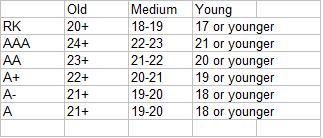
Prospects in the 1 to 5 range:
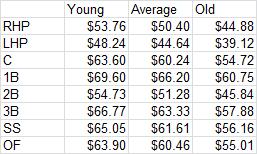
Prospects in the 6 to 15 range:
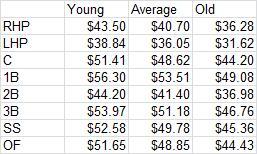

Prospects in the 6 to 15 range:

Prospects in the 16 to 40 range:
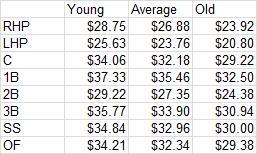
Prospects in the 41 to 75 range:

Prospects in the 76 to 100 range:
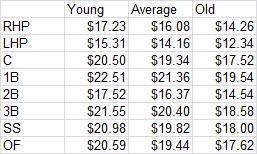
The tricky part of an Ervin Santana trade is that the acquiring team will no longer also receive the compensation draft pick if he departs the following offseason. What this means, is that for the Royals Santana and the draft pick is worth roughly 4.9 WAR, but for the acquiring team he is worth roughly 1.5 WAR. This is a difference of $17 million in terms of prospect value.
What should also be considered is that 1 win isn't valued equally. The Royals are going to be in a position on the win curve in which the 1.5 wins netted by Santana are less valuable than they would be for the Dodgers, who figure to need every additional win in order to survive a tight race in the National League West. How much the trading partners respective locations on the win curve becomes the key component in determining Santana's true value.
Another thing that should be considered is the net present value of those Wins Above Replacement. Obviously, Santana's 1.5 are going to occur immediately, but if we are looking at a window of ten years, a draft pick's value might not yield itself until years 4-10, while a prospect's value could yield itself as early as next season. Even if the draft pick's value and prospect's contributions were each 4 WAR, the prospect's value would be higher given the proximity of the contribution.
The Royals don't have to make the move. Just spit-balling, but from their perspective, they should probably target at least $20 million in value to really come out ahead. You can also access Baseball America's 2013 Top 100 here and their mid season top 50 here. Feel free to play with the list to determine if your prospect of choice fits the bill.
Mike Olt, who was just traded to Texas for Matt Garza, was worth roughly $21.5 million in value based on the charts and his mid-season ranking, but Chicago netted two additional prospects. I can't be sure of the value of those two prospects, but C.J. Edwards is highly regarded, and Grimm is Major League ready. The combination of these two likely easily passes the value of the package pass $30 million.
Joc Pederson, who many have attached their dreams to since Rany discussed him here, is worth $32.34 million based on the above chart. Could the Royals get him back if he was the only piece?
Adam Eaton of the Diamondbacks would be valued at approximately $22.5 million. Would Eaton and an arm like Andrew Chafin or Chase Anderson make sense?
I always hate to speculate on specific names, but this sort of information hopefully enables us to put a more firm valuation on the sort of prospect haul that the Royals should expect to receive. Take a look, do your dream trade scenarios make sense?
Follow me on Twitter @Landon_Adams

No comments:
Post a Comment